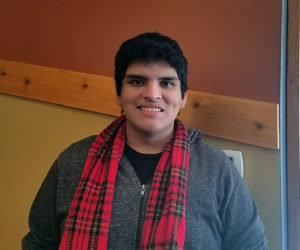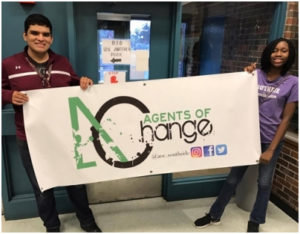By JAN WILLMS
Youth helping youth.
Sounds like a simple premise, but usually grants designed to assist young people are operated by adults.
A Bush Foundation grant awarded to Urban Arts Academy is unusual in its direct involvement of youth in its planning and operation.
 “Originally youth organizations in South Side Minneapolis came together to see what was wrong with their communities and try to fix it. They were trying to do this for about a year and realized they couldn’t. They decided to bring in youth from their organizations to come together and try to solve the dilemma they were in,” said Christopher Ortiz (photo right by Jan Willms), a young man who is working directly with the collaborative.
“Originally youth organizations in South Side Minneapolis came together to see what was wrong with their communities and try to fix it. They were trying to do this for about a year and realized they couldn’t. They decided to bring in youth from their organizations to come together and try to solve the dilemma they were in,” said Christopher Ortiz (photo right by Jan Willms), a young man who is working directly with the collaborative.
“The youth-serving organizations in South Minneapolis were not reaching all the kids and families with their programs,” explained Sandra Richardson, who serves as a program consultant, focusing on programming, fundraising, and sustainability for the project. “The agencies wondered how they could work more closely together, and they came up with a plan. Part of that plan was to have youth serve as navigators (a name that didn’t stick) and focus on four neighborhoods: Bryant, Central, Bancroft, and Powderhorn.” She said the decision was made to concentrate on those neighborhoods and not spread the program too thin. This was all happening around 2013 or 2014 before the grant was awarded.
“Sandra facilitated gathering all of those agencies for a year,” said Art Serotoff, motivator and project evaluator for the grant. “The result of their plan was the grant they submitted to Bush as an innovation grant. Bush saw the potential, and they liked it.”
Besides Urban Arts Academy, the organizations in the collaborative are Boys and Girls Club at Phelps, courageous heARTS, Full Cycle, Migizi School, Minneapolis Youth Farms, Pillsbury United Communities, WE WIN Institute, Centro, COMPAS, EDIT, Hennepin County A-GRAD, Minneapolis Youth Coordinating Board, Project Footsteps, SYWEG, YIPA and Neighborhood Associations of Bancroft, Bryant, Central and Powderhorn Park communities.
Up until this point, the people working on the grant were adults employed by the service agencies.
“Then they came up with the idea that they wanted to have the youth themselves work with the program,” Ortiz said. The first step was to change the name from Youth Navigators to Agents of Change (AOC). The youth said they did not like the term navigators—they were not a form of GPS.
“Selecting the name itself for the project was a long process,” Ortiz said. “We eventually called it AOC because we want to bring change to the community. We want to change the dynamic between adults and youth, so we are agents of change.”
 Photo left: Christopher Ortiz and Rayo Daniel (Photo submitted)
Photo left: Christopher Ortiz and Rayo Daniel (Photo submitted)
Ortiz said that initially the organizations enlisted youth who were participating in their programs. He was a high school senior and involved with Pillsbury House, one of the 20 collaborative members.
“One of the program leaders came up to me and told me about this new program for youth navigators. We didn’t receive much information other than that it’s a new youth program that wants to change youth programs. The other cherry on top was that we would get paid,” he continued. “I went, and it was different from what I expected. They were trying to find out what we wanted to do. That was a defining moment on becoming an Agent of Change. The motivator asked us what we saw wrong with our community, and we all responded honestly. At this time we saw what this could be.”
“We knew that if we’re really talking about something that would make a change, the youth would have to have a voice and be involved in it,” Richardson said. "But it was like when you’re having a baby, and you’ve been reading all the baby books for a year. You get your baby, and it doesn’t act like those babies in the books. So that’s what happened. We got the youth organizations and the youth didn’t act like our plan.”
Ortiz agreed. “We looked at the plan and we said nope, we have some other things we want to take care of. That was our real taste of what this program was to be about.”
Serotoff said the adults running these youth programs did step back and changed the direction of what the program was about. “Chris and other youth defined the core values,” he said.
“We came up with core values for each community,” Ortiz said. One value was to have real youth leadership opportunities and not just to have a program where youth are being taught to lead, but actually get an opportunity to lead.
Richardson noted that the youth participants said they were sick of going to programs on youth leadership and seminars, and at the end, there is no place for them to lead. “It wasn’t enough just to get information and education when there’s no place to use it.”
“The next value was ‘Don’t be like them,’” Ortiz said. “In going to middle school and high school, I witnessed a lot of my friends who fell through cracks. Society tries to forget about them and encourages us not to be like them. Everyone in the group agreed this is going on and is not unnoticed by us.” He said the youth do not want to be like them, referring to people who have let youth fall through the cracks. “We want to go to schools and push so that they do something to help those youth in need,” he said. “Every youth has a different story, and there may be actual reasons they are falling through the cracks.“
The third core value, according to Richardson, is that people need to value youth and demonstrate it. “Everyone says that, but if they don’t feel valued, what’s the point?” she asked.
Ortiz said the fourth core value was to tell the truth. “School and youth organizations don’t encompass all of history,” he stated. “There is a saying that history is told by the winners, and that plays a role in our schools. We are not really taught all of history from both sides and reflecting our own cultures.” He cited examples of African Americans learning their ancestors had been slaves, and that was it. “I realized as well, being Hispanic, that we immigrated here, and that was it. Nothing happened before." He said both schools and youth organizations should be pushed to teach students about their own cultures. “We just hammered on that specifically,” he said.
The project has set up a site visit guide, and Ortiz and one other high school Agent of Change member, Rayo Daniel, take that guide to each organization that is participating as a collaborator. “We interact with staff and youth participants in each organization,” he said. “Does this agency relate to our four core values? Would we recommend this program? We have done two site visit rounds and are planning a third in the upcoming months.”
“They are getting out in the community, like neighborhood consultants,” Serotoff added. “They table at events and ask kids what they are doing and talk about the potential of youth programs. They are referral agents doing outreach in the community. The goal is to develop this relationship with youth and family and organizations.”
He said the project wants an ongoing relationship—refer a youth to a program and then check back a month later and see how that referral is working, and if the program is responding to the core values. “If they are, communities will change. If not, we recommend improvements to the program.”
Ortiz, who is taking a gap year off from his current studies at Normandale Community College, emphasized how important being part of Agents of Change is to him.
“We want to see a different interaction or dynamic between youth and adults,” he said. “We are supposed to be the future hopes and dreams of the next generation, but we really don’t see that through adults’ actions, especially in the past couple years. We want to see that change.”
“Sandra and Art have been so helpful,” he commented. “Art acts as a supervisor, but more than that he is motivating us to do work that is youth-led.”
Richardson said the grant is funded through mid-2019. “The goal is to try and find additional agents and have youth connecting with youth programs in their communities.”
Ortiz sees nothing but growth for the future of Agents of Change. “We can’t let what is happening in the world push us down or let us lose our focus. Now more than ever, we need to push for families to come together, and for everyone to come together as a community not separated by race or economics...we are the Agents of Change.”
Comments
No comments on this item Please log in to comment by clicking here